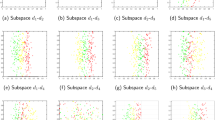Abstract
In Association rule mining, the quantitative attribute values are converted into Boolean values using fixed intervals. Conventional association rule mining algorithms are then applied to find relations among the attribute values. These intervals may not be concise and meaningful enough for human users to easily obtain non trivial knowledge from those rules discovered. Clustering techniques can be used for segmenting quantitative values into meaningful groups instead of fixed intervals. But the conventional clustering techniques like k-means and c-means require the user to specify the number of clusters and initial cluster centres. This initialization is one of the major challenges of clustering. A novel fuzzy based unsupervised clustering algorithm proposed by the authors is extended to segment quantitative values into fuzzy clusters in this paper. Membership values of quantitative items in the partitioning fuzzy clusters are used with weighted fuzzy rule mining techniques to find natural association rules. This fuzzy based method for handling quantitative attributes is compared with that of fixed intervals and segmenting using conventional k-means clustering method along with Apriori algorithm.





Similar content being viewed by others
References
Pujari AK (2001) Data mining techniques. University Press, Hyderabad
Hegland M (2003) Data mining–challenges, models, methods and algorithms. Publications of ANU Data Mining group, Draft
Agrawal R, Imieliński T, Swami A (1993) Mining association rules between sets of items in large databases. In: ACM SIGMOD Record vol 22, No. 2. ACM, pp 207–216
Han J, Kamber M (2001) Data mining: concepts and techniques. Elsevier, Delhi
Au WH, Chan KC (1999) FARM: a data mining system for discovering fuzzy association rules. In: IEEE international fuzzy systems conference proceedings, 1999. FUZZ-IEEE’99, vol 3, pp 1217–1222
Agrawal R, Shafer JC (1996) Parallel mining of association rules. IEEE Trans Knowl Data Eng 8:962–969
Binu T, Raju G (2010) A fuzzy threshold based modified clustering algorithm for natural data exploration. Lecture Notes Comput Sci 6122:167–172
Padmaja V Mining weighted association rules. Padmaja Int J Adv Eng Sci Technol (IJAEST) 11(1):153–156
Helm BL (2007) Fuzzy association rules an implementation in R. Master’s Thesis, Vienna University of Economics and Business Administration Vienna
Mangalampalli A, Pudi V (2008) Fuzzy logic-based pre-processing for fuzzy association rule mining. IIIT Hyderabad, India
Kruse R, Borgelt C, Nauck D (1999) Fuzzy data analysis: challenges and perspectives. In: IEEE International Fuzzy systems conference proceedings, 1999. FUZZ-IEEE’99, vol 3, pp 1211–1216
Halkidi M (2000) Quality assessment and uncertainty handling in data mining process. In: Proceedings of EDBT conference, Konstanz, Germany
Wai-Ho A, Chan KCC (2001) Classification with degree of membership: a fuzzy approach. In: Proceedings on IEEE international conference on data mining (ICDM)
Tao F, Murtagh F, Farid M (2003) Weighted association rule mining using weighted support and significance framework. In: Proceedings of the ninth ACM SIGKDD international conference on knowledge discovery and data mining, ACM, pp 661–666
Khan MS, Muyeba M, Tjortjis C, Coenen F (2007) An effective fuzzy healthy association rule mining algorithm (FHARM). In: Proceedings of UKCI, p 14
Muyeba M, Khan M, Coenen F (2009) Fuzzy weighted association rule mining with weighted support and confidence framework. New Front Appl Data Mining 5433:49–61
Muyeba M, Khan MS, Coenen F (2010) Effective mining of weighted fuzzy association rules. Computer 90:9
Cai CH, Fu AW, Cheng CH, Kwong WW (1998) Mining association rules with weighted items. In: Database engineering and applications symposium, 1998. Proceedings on IEEE international IDEAS’98, pp 68–77
Klawonn F, Keller A (1999) Fuzzy clustering based on modified distance measures. Adv Intell Data Anal 1642:291–301
Sankar KP, Mitra P (2002) Data mining in soft computing framework: a survey. IEEE Trans Neural Netw 13:11–18
Hong TP, Lee YC (2008) An overview of mining fuzzy association rules. In: Bustince H, Herrera F, Montero J (eds) Studies in fuzziness and soft computing, vol 220. Springer, Berlin, pp 397–410
Miller RJ, Yang Y (1997) Association rules over interval data. In: ACM SIGMOD Record, vol 26, No. 2, ACM, pp 452–461
Xiong X, Chan KL, Tan KL (2004) Similarity-driven cluster merging method for unsupervised fuzzy clustering. In: Proceedings of the 20th conference on uncertainty in artificial intelligence, AUAI Press, Arlington, VA, pp 611–618
Looney CG (1999) A fuzzy clustering and fuzzy merging algorithm. Reno, NV
Raju G, Singh A, Kumar TS, Thomas B (2008) Integration of fuzzy logic in data mining: a comparative case study. In: Proceedings of international conference on mathematics and computer science, Loyola College, Chennai, pp 128–136
Cox E (2005) Fuzzy modeling and genetic algorithms for data mining and exploration. Elsevier, India
Binu T, Raju G (2008) A modified fuzzy c means algorithm for natural data exploration. J World Acad Sci Eng Technol 49:478–481
Bezdek JC, Ehrlich R, Full W (1984) FCM: the fuzzy c means clustering algorithm. Comput Geosci 10(2):191–203
Thomas B, Raju G (2010) A fuzzy threshold based unsupervised clustering algorithm for natural data exploration. In: IEEE international conference on networking and information technology (ICNIT) 2010, pp 473–477
Fu A, Wong MH, Sze SC, Wong WC, Wong WL, Yu WK (1998) Finding fuzzy sets for the mining of fuzzy association rules for numerical attributes. In: Proceedings of the first international symposium on intelligent data engineering and learning, pp 263–268
Verlinde H, De Cock M, Boute R (2005) Fuzzy versus quantitative association rules: a fair data-driven comparison. IEEE Trans Syst Man Cybern Part B Cybern 36(3):679–684
Author information
Authors and Affiliations
Corresponding author
Rights and permissions
About this article
Cite this article
Thomas, B., Raju, G. A novel unsupervised fuzzy clustering method for preprocessing of quantitative attributes in association rule mining. Inf Technol Manag 15, 9–17 (2014). https://doi.org/10.1007/s10799-013-0168-7
Published:
Issue Date:
DOI: https://doi.org/10.1007/s10799-013-0168-7




